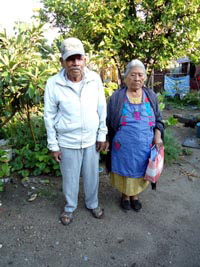You are here > Home > Food Articles >
|
|
|
|
|
Production of Pulque in Matatlán, Oaxaca
A Case Study of One Family’s Traditions
|
Alvin Starkman, M.A., LL.B. (Article archive) |
It’s still dark when Abraham CortĂ©s GarcĂa is in one of his fields on the outskirts of hometown Matatlán, harvesting aguamiel, the “honey water” used to produce the naturally fermented drink known as pulque (POOL – kay). He usually gets up at about 5 a.m., and either does the 20 minute walk to el campo on his own, or en route stops by son Lorenzo’s homestead to ask him to come along; or he picks up a neighborhood mozo, a young helper. At 77 years old, Abraham shows no sign of slowing down, a stunning revelation since later on in the day he must do his other chores both around the home and in the countryside, and then just before dusk finish collecting aguamiel for a second time.
Santiago Matatlán is in the Mexican state of Oaxaca, about an hour’s drive from the state capital. It’s one of the oldest colonial settlements in all of Mexico, founded in 1525, only a few years after the arrival of CortĂ©s. But the true notoriety of Matatlán is derived from its reputation as the world capital of mezcal, the distilled derivative of the agave (maguey) plant. In 1980, the town boasted 360 small mezcal factories (the number has greatly diminished since then). However pulque, not mezcal, reveals a more colorful history, dating to pre-Hispanic times.
Evidence suggests that the Spanish learned distillation from the Moors, and then imported rudimentary methods to the New World; thus the genesis of mezcal production. Mezcal is the byproduct of the heart, or piña, of certain varieties of agave (primarily the espadĂn) being baked, then crushed, fermented, and finally distilled.
Production of pulque, by contrast, begins with aguamiel which has been extracted from the core of distinctly different types of agave plants known as pulqueros. Once the pulquero has matured, after anywhere between 12 and 20 years of growth, the aguamiel is harvested and then fermented; no baking, no crushing, and no distilling. The preponderance of proof indicates that drinking pulque has been a tradition of the Zapotecs and other indigenous groups dating back as early at the 3rd century AD, often associated with ritualistic social and religious ceremonies.
Lorenzo is the eldest of Abraham and wife Victoria Hernández Mateo’s six children. He’s 55 years old, married with four children and several grandchildren. Lorenzo and his father are fortunate this morning, having this writer and his research assistant drive them to the fields. They’re lucky because it had rained most of the night, and the dirt roadways are much more difficult to navigate on foot than usual.
It’s still pitch black out, but Abraham and Lorenzo knowing their way is not an issue. On hundreds of previous occasions they’ve walked those same paths between rows of agave, nopal cactus, and freshly plowed furrows awaiting the sowing of corn. They also work other plots of family land, cultivating black beans and garbanzo, in an overall effort to maintain nutritional self-sufficiency.
For collecting aguamiel Abraham and Lorenzo bring along their simple yet effective tools of the trade. There’s the ten liter plastic receptacle (to others more commonly thought of as a gas can); a length of rubber hose taped to the neck of a 2.5 liter plastic Coca-Cola bottle; a funnel fashioned from another Coke bottle; and a slightly concave, razor sharp, one-piece metal raspador, 4 -5 inches in diameter with short handle.
|
The pulquero agave is one of the more majestic and attractive succulents one will ever encounter. At maturity it’s often ten feet tall, and 6 or more feet in diameter, counting the outer reaches of its curled blue-green leaves known as pencas, each of which has a slightly raised design on both sides. Because of the needle-sharp tip and series of thorn-like pricks forming the edges of each leaf, precautions must be taken before harvesting begins.
At maturity, a stock known as a chiote shoots up, extending almost 20 feet into the air. It’s cut down with a machete, or in the language of the trade, castrated, following which the plant is left for a week prior to the commencement of “tapping.” Several leaves are sheared off, while others are gingerly bent over backwards, the spiny tip inserted into and through a lower leaf. This reduces the likelihood of injury once harvesting aguamiel begins.
A specially forged and sharpened iron tool is then employed to carve out a cavity or well in the center of the plant from where the chiote had emerged. The well is perhaps 18 inches deep and six inches in diameter.
We walk through the mud, each step seemingly more difficult than the last, although only so much can cake onto one’s shoes. Abraham and Lorenzo are far ahead, knowing exactly where they will work this early morning, anxious to begin, and then finish harvesting from ten of their 400 plants. Darkness accentuates the feeling of tranquility; the air is fresh after the night’s rain; moon beams shine on the agave, enhancing their natural brilliance.
Abraham approaches a pulquero, steps up onto a makeshift wooden step stretching across and resting on the plant’s leaves, then ever so carefully reaches in and removes strategically placed thorn-laden branches from some type of bush; then a hand-hewn wooden top about ten inches in diameter; followed by a piece of cloth, then a smaller wooden lid, and finally a sling-shot shaped piece of wood. The plant’s inner sanctum is revealed.
In his broken Spanish (Zapoteco is his first language) Abraham explains:
“You see that colored liquid, that’s water, not aguamiel; we have to get that water out from last night’s rain, before reaching the aguamiel. The “Y” shaped piece of wood straddles the well opening so that little top stays in place and doesn’t fall in. The cloth keeps bees and other insects from getting at the aguamiel. The larger top actually has to be nudged into place between the leaves; it keeps them from bending forward and encroaching on the open well area. Then I put those spiny branches on top of everything. They keep the animals, especially possums, from getting at the well during the night. When we finish with each plant this morning I won’t have to put the branches back on top because the possums only come out at night, and I have to come back anyway in the late afternoon for the second harvest. Then I’ll put them back. Even though I use the two tops, and the cloth, look at how the water has managed to sneak in.”
|
Aguamiel is harvested twice daily; in the early hours of the morning, and again at the end of the day, the final chore before a late evening dinner. Abraham obtains an average of four to five liters of aguamiel per harvest, with luck 10 liters a day. Depending on the size of plant, it can be tapped in this way twice daily for between two to four months. But when it rains, less aguamiel is produced because the water displaces the hollow inside the well, the result being that less aguamiel can seep through the plant and into its cavity.
While assisting in some steps of the process, Lorenzo assumes more the role of a passive participant, appearing content to hand his father the tools as he is asked for them. Lorenzo’s still an apprentice in the eyes of dad. He will have finally gotten it right when his father is no longer able to do the harvest.
Lorenzo gives Abraham the hose – bottle contraption. Abraham lowers the bottle end into the cavity, then sucks on the hose. The rainwater enters the bottle through a small hole in its bottom. He pours the water on the ground, and then repeats the task. Finally he’s reached the milky aguamiel, so this time, with the aid of the funnel the liquid is directed into the gas can; the once again until the last drop has been suctioned from the well.
Using the raspador at the end of each harvest is the key to being able to obtain the maximum aguamiel the plant is able to yield. Abraham scrapes a thin layer of fleshy fiber from the inside of the well. The cloth and wooden pieces are then carefully placed on top of the cavity, in appropriate sequence, before moving onto the next plant.
Lorenzo and his father don’t go to the agave in the same row beside the first, but rather pass it by and continue walking until Abraham selects an alternate plant to be worked. He knows exactly where he’s going. He occasionally has to point Lorenzo in the right direction. The routine is repeated nine times.
Hard work is deserving of reward. It’s about 8 am, and all things considered the harvest has gone reasonably well, with three or four liters of aguamiel collected. Abraham pulls a small plastic soft drink bottle from his pocket, together with a tiny half gourd. We each have a couple of shots of mezcal before heading back to the house.
Late that afternoon, while Abraham is back in the fields with his team of oxen preparing the earth for planting, wife Victoria holds court with a few of her neighbors, one of whom translates from Zapoteco to Spanish:
“Let me get you some pulque, but wait, it’s pretty strong. Do you think you can tolerate it?”
Although 80 years old, her sight and hearing failing, Doña Victoria plays her part in the family business. She filters the aguamiel, and ensures that at least two grades of pulque are readied. She deftly controls the degree of fermentation, using strong pulque from a previous batch as a starter for the freshly harvested aguamiel, the goal being to adjust the percentage alcohol with the aid of time and ambient temperature, in order to achieve the desired kick. As the partner in charge of sales, she must have a good idea as to who will come by when, for how much, and the desired degree of fermentation for those particular customers – both neighbors and other townspeople, and the odd vendor who buys and resells either in Oaxaca or in weekly village marketplaces.
It’s been said that pulque is good for the white blood cells. But the women this afternoon chatting with Doña Victoria have differing beliefs. As is the case with all traditional tales regarding the relationship between food & drink and health, each is subject to conjecture and proof. One neighbor says “it’s good for the lungs,” while another assures that if drank after a period of fasting it invariably results in a longer and healthier life.
The culture of diplomacy in Oaxaca dictates that one does not lightly speak of the inferior quality of the product of the competition. One gleans only that there are a number of pulque producing families in Matatlán, some of whom may cut corners and use commercial additives. It’s the same subtle gossip that occurs within the mezcal industry, amongst Oaxaca’s rural producers: “our product is the real thing, 100% natural;” or, “she sells pulque in the markets, but she doesn’t grow agave, and doesn’t do the work that we do – she just buys from us, and from anyone else she chooses, and resells. So who knows about the quality?”
Whether drinking pulque made by the campesino who awakens with the roosters to harvest aguamiel before the sun begins to beat down, or purchasing in the markets, there’s a definite, distinct difference from the pulque produced for the commercial marketplace, and the real thing. One can only hope that when the time comes, Lorenzo will follow in his father’s footsteps.
Alvin Starkman has a Masters in anthropology and law degree from Osgoode Hall Law School. Now a resident of Oaxaca, Alvin writes, takes tours to the sights, is a consultant to documentary film companies, and owns Casa Machaya Oaxaca Bed & Breakfast (http://www.oaxacadream.com ), a unique Oaxaca bed and breakfast experience, providing Oaxaca accommodations which combine the comfort and service of Oaxaca hotels with the personal touch of quaint country inn style lodging.
|
|
|
|
|
|
|
|
|
|
|
 |

